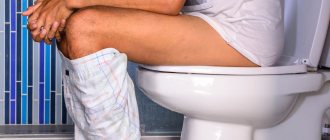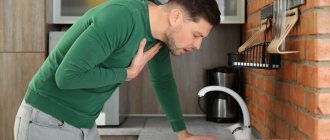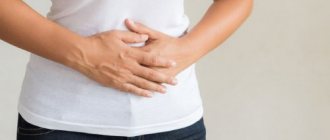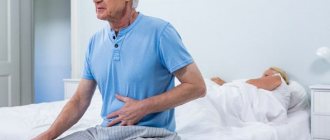Formation of gases in the intestines
The predominant microflora in the intestines “feeds” mainly on dietary fiber and incompletely digested carbohydrate residues - oligo- and disaccharides. Some carbohydrates and hard-to-digest fibers are not fully digested in the small intestine; from there they enter the large intestine and are used by microflora2,4.
Microbial fermentation processes are accompanied by the release of large amounts of gases. As a result of lactic acid fermentation, lactic acid, carbon dioxide, hydrogen, water and other substances are formed. Alcoholic fermentation leads to the appearance of carbon dioxide and ethanol, formic acid, propionic acid, butyric acid and other types lead to the release of volatile fatty acids, carbon dioxide, hydrogen and water. In addition, carbon dioxide is produced as a result of chemical alkalization of the acidic contents of the stomach in the duodenum4.
Methane is released during the vital activity of colon microflora and depends little on the composition of food, and hydrogen sulfide is released during the breakdown of sulfur-containing amino acids by microflora4.
If some processes accompanied by the release of gases are too active, and the removal of gases through the lower gastrointestinal tract is difficult, flatulence develops.
Types of flatulence depending on the cause of its development1,4
- Nutritional.
- Digestive.
- Dysbiotic.
- Dynamic.
- Mechanical.
- Circulatory.
- High-rise
- Psychogenic.
The syndrome of increased gas formation is closely associated with alimentary, digestive, dysbiotic and dynamic types of flatulence.
| Alimentary flatulence | mainly caused by aerophagia, that is, swallowing air, for example, during a rushed meal or conversation at the table, as well as by eating foods whose digestion is accompanied by increased gas formation1: fiber-rich vegetables and fruits, beans, peas, black bread, kvass, beer and others2 |
| Digestive flatulence (the name comes from “digestion” - digestion) | caused by disruption of food digestion1. Disturbances can occur due to an absolute or relative lack of digestive enzymes, in particular due to disruption of the pancreas, lactose and gluten intolerance, impaired bile acid metabolism and even overeating1,2 |
| Dysbiotic flatulence | develops due to a disturbance in the composition of the intestinal microflora and can accompany a variety of gastrointestinal diseases1 |
| Dynamic flatulence | occurs when there is a violation of intestinal motility, for example, with irritable bowel syndrome (IBS). Accelerated or slow movement of food through the intestines leads to disruption of digestion processes and changes in intestinal microflora. Therefore, dynamic flatulence is closely related to digestive and dysbiotic1,2 |
Up to contents
Diagnostics
During a physical examination, the proctologist draws attention to the gaping of the anus; with fecal incontinence, maceration of the skin around the anus is observed. To assess the closing function of the sphincter and identify signs of rectal pathology, a digital rectal examination is performed. To diagnose the causes of gas incontinence, the following laboratory and instrumental studies are used:
- Functional methods.
To study the contractile function and tonic tension of the anal sphincter, sphincterometry is indicated. Electromyography allows you to assess muscle tone. Diagnosis of reflex contractility of the anus is made by profilometry. - Sigmoidoscopy.
Endoscopy is the most informative method of visualizing the rectal mucosa. During the study, the doctor identifies inflammatory, erosive and tumor processes. If intestinal diverticula are suspected, a colonoscopy is required. - Radiography
. X-ray examination with oral contrast is informative for measuring the anorectal angle, studying the size and relief of the rectal mucosa. For a more detailed examination, irrigoscopy with double contrast is necessary. - Gynecological examination.
All women who complain of gas incontinence are advised to consult a gynecologist. The doctor performs a standard vaginal speculum examination. If a pathology is found, colposcopy, hysterosalpingoscopy, and ultrasound of the pelvic organs are indicated.
Symptoms of flatulence
Gaseous substances in the intestines are contained in a free and bound state. Free gases, thanks to intestinal peristalsis, constantly move towards the lower gastrointestinal tract and are excreted in portions: approximately 40 ml 15-20 times a day1,2.
Bound gases are enclosed in small bubbles lined with mucus4. With flatulence, their number increases sharply and foam forms. The increasing volume of foam leads to stretching of the intestinal wall. This causes discomfort in the abdomen, sensations of bloating, fullness and rumbling, as well as the development of pain. Additionally, abdominal enlargement and flatulence may be observed - frequent and profuse passage of gases, often with a foul odor and sound of varying timbre and volume1.
Symptoms of flatulence
- Regurgitation.
- Belching air.
- Feelings of bloating and fullness in the abdomen.
- Increase in abdominal circumference.
- Rumbling in the intestines.
- Stomach ache.
- The release of large amounts of gases from the intestines (flatulence)1.
The appearance of abdominal pain during flatulence is associated with overstretching of the intestinal walls and its mesentery. The degree of discomfort depends on the height of the pain sensitivity threshold: the lower this threshold, the more severe the pain. It appears in one part of the abdomen, gradually intensifies, then, as the gas bubble moves through the intestines, it weakens and even disappears, but then appears again, albeit in a different place in the abdominal cavity1.
Foamed stool covers the intestinal walls and makes it difficult to digest food and absorb nutrients1. This further complicates the situation: undigested food remains accumulate in the intestines and fermentation processes intensify. Gas formation increases, the symptoms of flatulence become even more pronounced.
If it persists for a long time, flatulence can disrupt a person’s usual way of life, force him to give up active pastime and limit communication. This can lead to psychological problems, increased anxiety and depression2.
Up to contents
Taking a natural laxative
If diet does not help normalize bowel movements, you should buy an effective remedy for constipation at the pharmacy. Doctors do not recommend choosing drugs containing senna, since such drugs act aggressively and often cause side effects. Therefore, before purchasing, carefully study the information on the packaging.
Psyllium, the shell of plantain seeds, gives a good effect. This component retains water in the intestines, thereby increasing the volume of its contents. Psyllium, together with the pulp of domestic plum fruits - sources of soluble dietary fiber - is part of the English drug "Fitomucil Norm". The biocomplex contains 4 times more soluble fiber than bran.
Soluble fibers, swelling in the intestines and turning into a gel, soften the stool, which facilitates their easy excretion. And insoluble fiber mechanically stimulates the intestinal walls to remove waste.
"Fitomucil Norm" gently restores regular bowel movements without such unpleasant symptoms as pain, cramps and bloating, and creates conditions for the growth of beneficial microflora. Unlike stimulant laxatives, the drug can be used for a long time, as it is not addictive and has no side effects.
You can buy the product in pharmacies. Instructions for use are presented on the website and in the packaging.
Foods that cause flatulence
Scientists have proven and repeatedly confirmed the role of nutrition in the occurrence of flatulence2,3.
Products that increase gas formation2,3:
- legumes,
- cabbage,
- spinach,
- sorrel,
- onion and garlic,
- radishes and turnips,
- carrot,
- celery,
- dates,
- bananas,
- apples,
- gooseberry,
- raspberries,
- kvass and beer,
- black bread,
- raisin,
- prunes,
- whole milk,
- carbonated drinks,
- caffeinated drinks,
- alcohol1,3.
Products containing carbohydrates are recognized as dangerous from the point of view of increased gas formation: oligosaccharides, disaccharides, monosaccharides and polyols7. All these carbohydrates are united by the term “FODMAP”, meaning Fermentable Oligo-, Di-, Mono- and Polyol. They are poorly absorbed in the intestine; remaining in it, they become food for bacteria and provoke the development of flatulence with all its inherent symptoms3,7.
FODMAP - foods containing “dangerous” carbohydrates
| Oligosaccharides (fructans and galactans) | vegetables: beets, white cabbage and Brussels sprouts, broccoli and garlic, onions, leeks and shallots, artichokes and asparagus, dill and okra (okra) |
| beans (including green beans), chickpeas, lentils and peas | |
| fruits: apples, watermelons, white peaches, persimmons, rambutan | |
| all cereals made from rye and wheat, as well as products made from them | |
| Disaccharides (lactose) | regular and low-fat cow's milk, goat's milk |
| ice cream made from whole milk and cream | |
| regular and low-fat yogurts | |
| soft cheeses: mozzarella, suluguni, Adyghe, fat cream cheeses | |
| Monosaccharides (fructose) | apples, pears, peaches, watermelon and mangoes, especially in large quantities |
| juices and concentrated sauces from the listed fruits | |
| dried fruits and canned fruits | |
| honey and products containing it | |
| Polyols (sugar alcohols) | fruits: watermelons, apples, pears, plums, prunes, apricots, peaches, nectarines, cherries, avocados, lychees |
| vegetables: all types of cabbage and green peas | |
| mushrooms | |
| sweeteners: isomaltitol, maltitol, mannitol, sorbitol, xylitol, as well as sweeteners ending in “-ol”, such as erythritol |
Up to contents
Ways to get rid of bloating
Flour products can provoke flatulence
Compliance with preventive measures will help significantly alleviate the condition. You should avoid provoking foods. Foods with small amounts of simple carbohydrates will not cause flatulence.
You need to add dried fruits, lean meat, nuts and eggs to your diet. The most harmful foods are confectionery, fruit juices, soy, cauliflower and Brussels sprouts.
Drinks high in fructose can also cause bloating. It is also very important to understand that each patient has individual provoking foods, so it is necessary to independently determine a safe diet.
Treatment of flatulence
Treatment of flatulence primarily involves eliminating the cause that caused it. If bloating is associated with a gastrointestinal disease, you can get rid of it only by restoring the functioning of the digestive system1.
The main directions of flatulence therapy6:
- Diet and diet correction9.
- Drug therapy:
- normalization of intestinal microflora with the help of pre-, pro- and synbiotic drugs;
- transferring gases from a bound state to a free one and removing them from the intestines with the help of “defoamers”.
Up to contents
Diet and nutrition
Treatment of flatulence begins with normalization of nutrition1,2. Doctors recommend eating small meals 5-6 times a day and be sure to have breakfast. Moreover, for breakfast it is better to eat dishes made from grain crops, that is, porridge, pasta, flour products1.
You need to eat in a calm environment, slowly and chewing every bite thoroughly. Do not talk while eating, much less smoke, to prevent air from entering the stomach - aerophagia6. Aerophagia is one of the main factors leading to flatulence1,6. For the same reason, you should not drink through a straw or drink carbonated drinks2,6.
There is no universal diet that would prevent and reduce the manifestations of flatulence. The nature of nutrition is determined by the underlying disease that caused increased gas formation in the gastrointestinal tract. So, with lactase deficiency, it is often enough not to consume foods containing oligosaccharides, in particular milk sugar - lactose. And with irritable bowel syndrome, it is better to exclude from the diet everything that provokes gas formation2. If you are intolerant to certain types of carbohydrates, the FODMAP diet will help you create a healthy diet.
FODMAP diet: allowed foods
| For fructose intolerance | Vegetables - everything |
| Cereals - everything | |
| Fruits: bananas, orange, lemon, lime, grapefruit, grapes, melon, kiwi | |
| Instead of honey - maple syrup and light molasses | |
| Sugar (sucrose), as sweeteners - any sweeteners, except polyols | |
| For lactose intolerance | Vegetables, fruits - everything |
| Products made from grain and flour without dairy additives | |
| Milk: lactose-free, soy | |
| Instead of regular ice cream - frozen juices and sherbet | |
| Lactose-free yoghurts | |
| Only hard cheeses | |
| In case of intolerance to oligo-disaccharides | Vegetables: pumpkin, corn, carrots, celery, green beans, eggplant, bok choy, capsicum, green onions, lettuce, chard, parsnips, bamboo shoots |
| Fruits - everything | |
| Cereals: gluten-free bread and flour products, spelled products, cereals (excluding wheat) | |
| For intolerance to polyols | Fruits: orange, lemon, lime, grapefruit, kiwi, bananas, grapes, melon, star fruit, durian, passion fruit, papaya |
| Vegetables - everything except cabbage and green peas | |
| Cereals - everything | |
| Sugar (sucrose), as a sweetener - everything that does not end in “-ol”3 |
For any nature of flatulence, it is recommended to limit the consumption of indigestible meat (pork, lamb, goose), sugar and sweet flour products. It is better to steam, stew or boil food. Use bread made from wholemeal flour and preferably yesterday's bread, that is, slightly dried out1.
Up to contents
Drug therapy
Since in most cases flatulence is combined with a violation of the intestinal microflora, treatment is primarily aimed at normalizing its composition1,2,9.
For this, doctors prescribe:
- Probiotics are preparations that contain microorganisms that help restore intestinal microflora; preference is given to products based on lactobacilli and bifidobacteria1,2;
- Prebiotics are a substrate for feeding “beneficial” bacteria inhabiting the gastrointestinal tract, for example, lactulose;
- Synbiotics are preparations based on bacteria that are part of the normal intestinal microflora and nutrients for them1.
In case of severe enzyme deficiency, drugs based on pancreatic enzymes are used. They improve digestion, reduce the content of undigested food residues in the intestines and thereby eliminate the soil for the processes of microbial fermentation and excessive gas formation1,2,9.
Simethicone preparations1,2,9, such as Motilegaz® Forte, can be used as a means of quick relief from flatulence, allowing relief from bloating.
Up to contents
Motilegaz® Forte – first aid for flatulence
MOTILEGAZ® FORTE is a medicinal product based on an active substance with the international nonproprietary name “simethicone”, which has an antifoaming and carminative effect10.
The drug is available in soft gelatin capsules, which are tasteless and odorless and are easy to swallow.
Mechanism of action of MOTILEGAZ® FORTE
- Once in the gastrointestinal tract, the capsule dissolves and releases the active substance - simethicone.
- Simethicone “spreads” over the surface of gas bubbles, increases the surface tension of their walls, promotes their rupture and the release of gaseous substances.
- The resulting free gases are partially absorbed in the intestine. The other part of the gases is released from the intestines naturally.
The drug MOTILEGAZ® FORTE acts directly in the intestines. Simethicone is a chemically inert polymer, is not absorbed into the gastrointestinal tract and does not enter the general bloodstream. This ensures a high safety profile of the drug.
MOTILEGAZ® FORTE is approved for use from the age of 18 years10.
Up to contents
The information in this article is for reference only and does not replace professional advice from a doctor. To make a diagnosis and prescribe treatment, consult a qualified specialist.
Literature
- Gureev A. N. Syndrome of increased gas formation // Regular issues of “RMZh”. —2010. - No. 5. — P. 306.
- Belmer S.V., Kovalenko A.A., Gasilina T.V. Flatulence: norm and pathology // Attending physician. - 2008. - No. 2. — P. 38-42.
- Dicheva D. T., Kazyulin A. N., Russ I. S. et al. Diet therapy with a reduced content of fermentable oligosaccharides, disaccharides, monosaccharides and polyols (FODMAP) for irritable bowel syndrome // Consilium Medicum. - 2016; 18 (8): 75–78.
- V. Makhov Flatulence: from pathogenesis to treatment // Doctor - 2010 - No. 3 - P.20-24
- A. Nogaller. Flatulence: causes and treatment // Doctor – 2016 – No. 7 – P.6-8
- Yu.O. Shulpekova. Flatulence: circle of knowledge or circle of ignorance // Medical Council - 2013 - No. 10 - pp. 54-58.
- Yu.O. Shulpekova Bloating: analysis of the origin of the symptom // Attending physician. - 2022. - No. 8. — P. 16-25.
- I.B. Khlynov Galactooligosaccharide-dependent flatulence and bloating // Attending physician. - 2022. - No. 9.
- L. I. Butorova, N. G. Kadnikova, etc. Bloating and gas formation: modern treatment options // Attending physician. - 2018. - No. 2. — P. 61-66
- Instructions for medical use MOTILEGAZ® FORTE.
Up to contents
Lifestyle change
In the treatment of flatulence, daily routine and healthy habits are important. It is necessary to increase the frequency of meals, up to 5-6 times a day. Breakfast should consist of cereals.
It is important that each meal is calm; there is no need to talk during lunch. Try to chew your food thoroughly and take your time—allow enough time for lunch and snacks during the day. You should also not eat food while lying down. It is better to avoid drinking drinks through a straw or sucking on caramel.
A sufficient amount of water is important in the fight against stool disorders and the formation of large amounts of gas. Researcher Shulpekova in her scientific work points out that “sufficient fluid intake is up to 2–2.5 l/day. helps soften feces and diffusion of gases into the bloodstream” (Shulpekova Yu. O., 2013, p. 57).
You can help yourself with a food diary. Record the foods you eat and your feelings in it. This way you can understand which foods make your symptoms worse.










